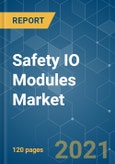The safety IO modules market is expected to register a CAGR of 5.85% by 2021-2026. The importance of safety IO devices rose from the terrible need for efficient and reliable infrastructure in hazardous environments. The IO devices are being used in the industry for optimizing the automation process. These modules also decrease the installation time and expense, as they are an integral part of the input/output control system, and hence, reduces the need for third-party relays and mapping equipment.
Key Market Trends
Increasing Demand of Safety IO Modules in Automotive Industry to Drive the Market Growth
North America to Have the Largest Market Share
Competitive Landscape
The safety IO modules market is consolidated due to a few major players are having a huge share of the market. Some of the key players include ABB Ltd., Siemens AG, Rockwell Automation Inc., Schneider Electric, Honeywell International Inc., Advantech Co.Ltd.l, Parmley Graham Ltd., Weidmuller Interface GmbH & Co. KG, among others.
Reasons to Purchase this report:
This product will be delivered within 2 business days.
- The safety IO modules provide all the basic advantages that the traditional distributed IO safety systems provide. With the help of these new modules, one can control and monitor their safety devices.
- Moreover, one can also detect a failure at IO and field device levels, along with enhancing the operator protection. The growing technological advancements have improved the safety parameters associated with these IO modules, making their use in the hazardous zones even more feasible. This technological growth is bound to bring more improvements in the quality of safety in IO modules in the future.
- The increasing demand for safety IO modules is a direct consequence of the increase in the number of hazardous areas. Rising frequency of accidents in these hazardous areas has led to the establishment of industrial regulatory standards, which drove the demand for safety infrastructure in the market, thereby, steering the market growth.
- On the contrary, lack of awareness about the robust and reliable IO modules has been a challenge hindering the market growth in the recent past.
Key Market Trends
Increasing Demand of Safety IO Modules in Automotive Industry to Drive the Market Growth
- The automotive industry is experiencing a paradigm shift with increasing integration of technology. The autonomous car technology is rapidly advancing with companies investing heavily in this technology. The demand for electric cars is also growing, with companies introducing affordable electric vehicles.
- This is expected to result in higher demand for automobiles, pushing companies to up their manufacturing capabilities, and establish plants.
- As safety IO models offer increased reliability and safety without compromising on the operational efficiency, the industry is moving towards safety IO systems. Thus, the automotive industry is expected to be the fastest growing market for safety IO modules, during the forecast period.
- As safety IO models offer increased reliability and safety without compromising on the operational efficiency, the industry is moving towards safety IO systems. Thus, the automotive industry is expected to be the fastest growing market for safety IO modules, during the forecast period.
- With the growing demand for automobiles across the world, companies are pushing towards automated systems to increase the productivity of the existing plants.
- Many automotive manufacturers are either establishing new manufacturing infrastructure across the world or moving the processes in automotive manufacturing, from manual labor to robotic machinery. Thus, with the increase in the number of industrial robots and automation, there is a need for interfacing these systems with centralized controllers. The automotive industry is thus deploying IO modules, for monitoring, data collecting, and controlling these systems.
North America to Have the Largest Market Share
- The key factors contributing to the growth of the North America safety IO modules market are demand for intrinsically safe IO modules, compulsory industrial or government safety standards, miniaturization of devices, demand for reduced wiring cost and reduced start-up machine time.
- The United States is one of the top five countries that import the highest number of high-voltage protection equipment as well as low-voltage equipment, accounting for an import value of nearly USD 718 million (for high-voltage protection equipment) and a USD 9.26 billion (for low-voltage protection equipment).
- Besides, the United States has the largest and most technologically developed economy in the world, with a positive per capita GDP. Business firms in the United States enjoy a greater degree of flexibility compared to businesses in Japan and Western Europe in terms of innovation and expansion. Therefore, equipped with a high-tech industrial economy, the need for automation and safety in the industrial environment drive the market growth in the region.
Competitive Landscape
The safety IO modules market is consolidated due to a few major players are having a huge share of the market. Some of the key players include ABB Ltd., Siemens AG, Rockwell Automation Inc., Schneider Electric, Honeywell International Inc., Advantech Co.Ltd.l, Parmley Graham Ltd., Weidmuller Interface GmbH & Co. KG, among others.
- January 2019 - Rockwell Automation, Inc. acquired Emulate3D, an innovative engineering software developer whose products digitally simulate and emulate industrial automation systems. By using accurate simulation models to improve systems planning and decision-making, followed by emulation trials that test the control system before installation, Emulate3D’s software enables customers to virtually test machine and system designs before incurring manufacturing and automation costs and committing to a final design.
Reasons to Purchase this report:
- The market estimate (ME) sheet in Excel format
- 3 months of analyst support
This product will be delivered within 2 business days.
Table of Contents
1 INTRODUCTION
4 MARKET DYNAMICS
5 MARKET SEGMENTATION
6 COMPETITIVE LANDSCAPE
Companies Mentioned (Partial List)
A selection of companies mentioned in this report includes, but is not limited to:
- ABB Ltd.
- Siemens AG
- Rockwell Automation Inc.
- Schneider Electric
- Parmley Graham Ltd.
- Honeywell International Inc.
- Advantech Co. Ltd.
- Weidmuller Interface GmbH & Co. KG
Methodology

LOADING...








